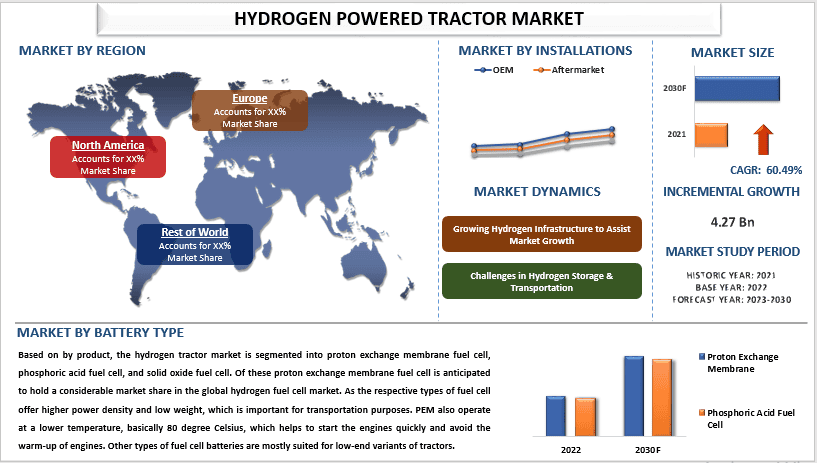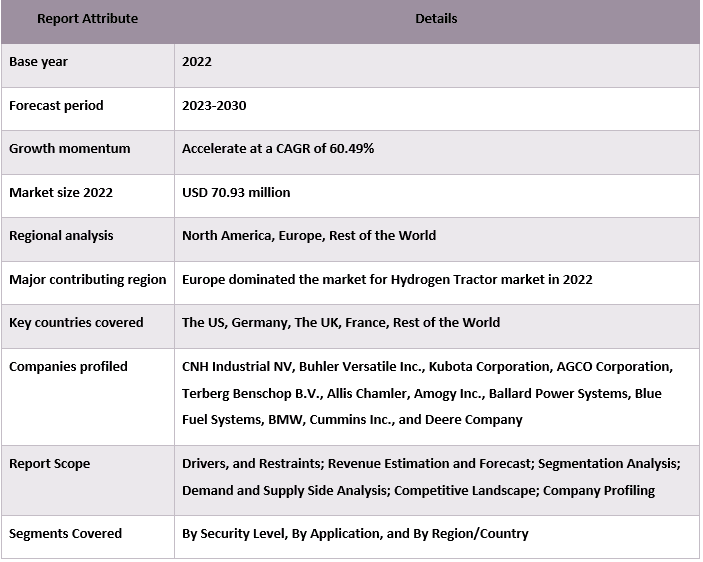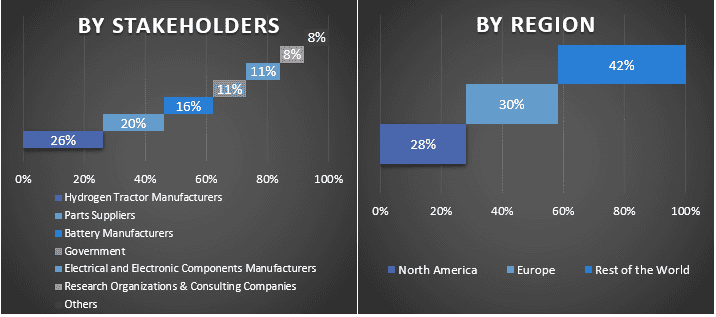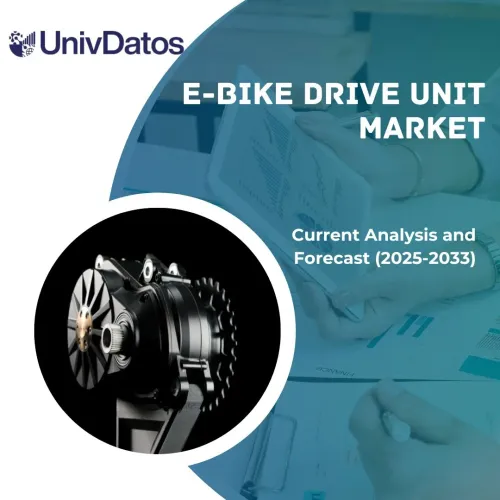- Inicio
- Acerca de nosotros
- Industria
- Servicios
- Leyendo
- Contáctenos
Mercado de tractores propulsados por hidrógeno: análisis actual y previsión (2023-2030)
Énfasis en el tipo de batería (celda de combustible de membrana de intercambio de protones, celda de combustible de ácido fosfórico y celda de combustible de óxido sólido); Instalación (OEM y mercado de accesorios); y Región/País

Se espera que el mercado mundial de tractores propulsados por hidrógeno alcance los 4270 millones de dólares en 2030, con un crecimiento a una tasa de crecimiento anual compuesto (CAGR) del 60,49%. Uno de los factores atribuidos al lento crecimiento fue la menor disponibilidad de modelos de tractores que utilizan transmisión eléctrica de pila de combustible. Además, con los precios más altos del modelo existente de tractores FCEV, la demanda de los respectivos productos también fue menor.
OBTENGA UNA MUESTRA DEL INFORME
Sin embargo, dado que varias empresas fabricantes de tractores están trabajando extensamente en el desarrollo y el lanzamiento de tractores de hidrógeno, se prevé que el mercado prospere en los años previstos, es decir, 2023-2030. En 2021, Hyundai anunció su proyecto NorCal Zero, que comenzará a operar 30 Xcient FCEV en California en el segundo trimestre de 2023. Se dijo que era el mayor despliegue comercial de camiones y tractores eléctricos de pila de combustible de hidrógeno de Clase 8 en los EE. UU.
Además, existen otros factores que pueden contribuir al aumento de la demanda de tractores de hidrógeno, como el aumento del apoyo gubernamental en términos de subvenciones, la facilidad para establecer unidades de fabricación, etc.
Para la adopción de tractores eléctricos de pila de combustible de hidrógeno, es necesario primero desarrollar el ecosistema de producción y distribución de hidrógeno. Recientemente se han observado varias iniciativas gubernamentales que se prevé que promuevan el establecimiento de este ecosistema. Por ejemplo, en enero de 2023, el gobierno de la India anunció una inversión de aproximadamente 2400 millones de dólares en el marco de su Misión Nacional del Hidrógeno. La inversión ayudaría en planes de incentivos vinculados para los compradores, así como a mejorar la producción de hidrógeno dentro de la India.
Además, con un alto grado de enfoque en la sostenibilidad en todos los modos de actividades comerciales, de los cuales el trabajo agrícola es una parte crucial, la necesidad de transformar los tractores de diésel a eléctricos de pila de combustible (hidrógeno) también ha sido mayor. Según la Agencia Internacional de Energía (IEA), la adopción del hidrógeno en todo el mundo ha sido mayor.
Según H2stations.org, alrededor de 1700 estaciones de servicio de hidrógeno estaban presentes en todo el mundo en 2023. De estas, una parte importante de las estaciones de servicio de hidrógeno se encontraban en la región de Asia-Pacífico. Especialmente, China y Japón han sido los precursores en términos de la adopción de hidrógeno para la próxima adopción de nuevos medios de transporte que dependen de él.
Algunos de los principales actores que operan en el mercado son CNH Industrial NV, Buhler Versatile Inc., Kubota Corporation, AGCO Corporation, Terberg Benschop B.V., Allis Chamler, Amogy Inc., Ballard Power Systems, Blue Fuel Systems, BMW, Cummins Inc. y Deere Company. Estos actores han llevado a cabo varias fusiones y adquisiciones junto con asociaciones para facilitar a los clientes productos/tecnologías innovadores y de alta tecnología.
Información presentada en el informe
“Entre los tipos de batería, el segmento de membrana de intercambio de protones dominó el mercado en 2022”.
Según el producto, el mercado de tractores de hidrógeno está segmentado en pila de combustible de membrana de intercambio de protones, pila de combustible de ácido fosfórico y pila de combustible de óxido sólido. De estos, se prevé que la pila de combustible de membrana de intercambio de protones tenga una cuota de mercado considerable en el mercado mundial de pilas de combustible de hidrógeno. Como los respectivos tipos de pilas de combustible ofrecen una mayor densidad de potencia y un bajo peso, lo cual es importante para fines de transporte. La PEM también opera a una temperatura más baja, básicamente 80 grados Celsius, lo que ayuda a arrancar los motores rápidamente y evitar el calentamiento de los motores. Otros tipos de baterías de pilas de combustible son más adecuados para las variantes de gama baja de tractores con un uso operativo limitado.
“Entre las instalaciones, el segmento de modernización generó los mayores ingresos en 2022”.
El mercado mundial de tractores de hidrógeno se encuentra en la fase inicial, ya que la mayoría de los fabricantes están trabajando en la modernización de la vasta flota de tractores existente con tecnología de pilas de combustible de hidrógeno. A medida que el uso de combustible sostenible para equipos agrícolas, incluidos los tractores, está mejorando rápidamente, muchas de las empresas han comenzado a ofrecer un dispositivo de modernización adicional para transformar los modelos de tractores existentes para que funcionen parcial o totalmente con hidrógeno. Por ejemplo, en 2020, New Fuel Station junto con New Holland anunciaron el lanzamiento de una combinación de tractores de hidrógeno y diésel. El tractor está equipado con cinco cilindros de 11,5 kg de capacidad de hidrógeno.
“Europa dominó el mercado de tractores de hidrógeno en 2022”.
Europa es uno de los principales mercados de tractores de hidrógeno debido al gran enfoque de los países de la región en la reducción de las emisiones de carbono a través de todos los vehículos utilizados para fines agrícolas y de transporte. Además, algunos de los otros factores también han demostrado ser propicios para el desarrollo y la adopción de la respectiva tecnología. Esto incluye las políticas gubernamentales, la inclinación del sector privado a ofrecer productos con bajas o nulas emisiones de carbono, la concienciación de los consumidores sobre las bajas emisiones y la reducción de los costes operativos.
Algunos de los acontecimientos recientes observados son los siguientes: En 2020, los Países Bajos se convirtieron en el primer país en lanzar un tractor de combustible de hidrógeno en toda regla. New Holland Tractors, junto con Blue Fuel Solutions, desarrollaron un tractor de hidrógeno con 11,5 kg de hidrógeno y 470 litros de almacenamiento de agua. El modelo utiliza una combinación de hidrógeno y mezcla de diésel para lograr su potencia óptima.
Sin embargo, a medida que crece la aplicación del hidrógeno, también crece la atención en la mejora de la capacidad de producción.
Cobertura del informe sobre el mercado de tractores de hidrógeno

Razones para comprar este informe:
- El estudio incluye análisis de tamaño del mercado y pronósticos validados por expertos clave autenticados de la industria.
- El informe presenta una revisión rápida del desempeño general de la industria de un vistazo.
- El informe cubre un análisis en profundidad de pares destacados de la industria con un enfoque principal en las finanzas comerciales clave, las carteras de productos, las estrategias de expansión y los desarrollos recientes.
- Examen detallado de los impulsores, las restricciones, las tendencias clave y las oportunidades que prevalecen en la industria.
- El estudio cubre exhaustivamente el mercado en diferentes segmentos.
- Análisis profundo a nivel regional de la industria.
Opciones de personalización:
El mercado mundial de tractores de hidrógeno se puede personalizar aún más según los requisitos o cualquier otro segmento de mercado. Además de esto, UMI entiende que usted puede tener sus propias necesidades comerciales, por lo tanto, no dude en contactarnos para obtener un informe que se adapte completamente a sus necesidades.
Tabla de contenido
Metodología de Investigación para el Análisis del Mercado de Tractores de Hidrógeno (2023-2030)
Analizar el mercado histórico, estimar el mercado actual y pronosticar el mercado futuro del mercado global de Tractores de Hidrógeno fueron los tres pasos principales realizados para crear y analizar la adopción de Tractores de Hidrógeno en las principales regiones a nivel mundial. Se llevó a cabo una investigación secundaria exhaustiva para recopilar las cifras históricas del mercado y estimar el tamaño actual del mercado. En segundo lugar, para validar estos conocimientos, se tomaron en consideración numerosos hallazgos y suposiciones. Además, también se realizaron entrevistas primarias exhaustivas con expertos de la industria en toda la cadena de valor del mercado global de Tractores de Hidrógeno. Después de la suposición y validación de las cifras del mercado a través de entrevistas primarias, empleamos un enfoque de arriba hacia abajo/de abajo hacia arriba para pronosticar el tamaño completo del mercado. Posteriormente, se adoptaron métodos de desglose del mercado y triangulación de datos para estimar y analizar el tamaño del mercado de los segmentos y subsegmentos de la industria a la que pertenece. La metodología detallada se explica a continuación:
Análisis del Tamaño Histórico del Mercado
Paso 1: Estudio Profundo de Fuentes Secundarias:
Se realizó un estudio secundario detallado para obtener el tamaño histórico del mercado de Tractores de Hidrógeno a través de fuentes internas de la empresa, como informes anuales y estados financieros, presentaciones de desempeño, comunicados de prensa, etc., y fuentes externas, incluyendo revistas, noticias y artículos, publicaciones gubernamentales, publicaciones de la competencia, informes del sector, bases de datos de terceros y otras publicaciones creíbles.
Paso 2: Segmentación del Mercado:
Después de obtener el tamaño histórico del mercado de Tractores de Hidrógeno, realizamos un análisis secundario detallado para recopilar información histórica del mercado y compartirla para diferentes segmentos y subsegmentos para las principales regiones. Los principales segmentos se incluyen en el informe, como el nivel de seguridad y la aplicación. Además, se llevaron a cabo análisis a nivel de país para evaluar la adopción general de modelos de prueba en esa región.
Paso 3: Análisis de Factores:
Después de adquirir el tamaño histórico del mercado de diferentes segmentos y subsegmentos, realizamos un análisis de factores detallado para estimar el tamaño actual del mercado de Tractores de Hidrógeno. Además, realizamos un análisis de factores utilizando variables dependientes e independientes, como el nivel de seguridad y la aplicación del mercado de Tractores de Hidrógeno. Se realizó un análisis exhaustivo de los escenarios de demanda y oferta considerando las principales asociaciones, fusiones y adquisiciones, expansión comercial y lanzamientos de productos en el sector del mercado de Tractores de Hidrógeno en todo el mundo.
Estimación y Pronóstico del Tamaño Actual del Mercado
Tamaño Actual del Mercado: Basándonos en información práctica de los 3 pasos anteriores, llegamos al tamaño actual del mercado, los actores clave en el mercado global de Tractores de Hidrógeno y las cuotas de mercado de los segmentos. Todos los porcentajes de participación requeridos, la división y el desglose del mercado se determinaron utilizando el enfoque secundario mencionado anteriormente y se verificaron a través de entrevistas primarias.
Estimación y Pronóstico: Para la estimación y el pronóstico del mercado, se asignaron ponderaciones a diferentes factores, incluidos los impulsores y las tendencias, las restricciones y las oportunidades disponibles para las partes interesadas. Después de analizar estos factores, se aplicaron técnicas de pronóstico relevantes, es decir, el enfoque de arriba hacia abajo/de abajo hacia arriba, para llegar al pronóstico del mercado para 2030 para diferentes segmentos y subsegmentos en los principales mercados a nivel mundial. La metodología de investigación adoptada para estimar el tamaño del mercado abarca:
- El tamaño del mercado de la industria, en términos de ingresos (USD) y la tasa de adopción del mercado de Tractores de Hidrógeno en los principales mercados a nivel nacional.
- Todos los porcentajes de participación, divisiones y desgloses de los segmentos y subsegmentos del mercado.
- Actores clave en el mercado global de Tractores de Hidrógeno en términos de productos ofrecidos. Además, las estrategias de crecimiento adoptadas por estos actores para competir en el mercado de rápido crecimiento.
Validación del Tamaño y la Cuota de Mercado
Investigación Primaria: Se realizaron entrevistas en profundidad con los Líderes de Opinión Clave (KOL) que incluyen a los Ejecutivos de Alto Nivel (CXO/VP, Jefe de Ventas, Jefe de Marketing, Jefe de Operaciones, Jefe Regional, Jefe de País, etc.) en las principales regiones. Luego, se resumieron los hallazgos de la investigación primaria y se realizó un análisis estadístico para probar la hipótesis establecida. Las aportaciones de la investigación primaria se consolidaron con los hallazgos secundarios, convirtiendo así la información en conocimientos prácticos.
División de Participantes Primarios en Diferentes Regiones

Ingeniería de Mercado
Se empleó la técnica de triangulación de datos para completar la estimación general del mercado y para llegar a cifras estadísticas precisas para cada segmento y subsegmento del mercado global de Tractores de Hidrógeno, los datos se dividieron en varios segmentos y subsegmentos después de estudiar varios parámetros y tendencias en las áreas de tipo de batería e instalación en el mercado global de Tractores de Hidrógeno.
El objetivo principal del Estudio del Mercado de Tractores de Hidrógeno
Las tendencias actuales y futuras del mercado global de Tractores de Hidrógeno se señalaron en el estudio. Los inversores pueden obtener información estratégica para basar su criterio para las inversiones en el análisis cualitativo y cuantitativo realizado en el estudio. Las tendencias actuales y futuras del mercado determinaron el atractivo general del mercado a nivel regional, proporcionando una plataforma para que el participante industrial explote el mercado sin explotar para beneficiarse de una ventaja de ser el primero en actuar. Otros objetivos cuantitativos de los estudios incluyen:
- Analizar el tamaño actual y previsto del mercado de Tractores de Hidrógeno en términos de valor (USD). Además, analizar el tamaño actual y previsto del mercado de diferentes segmentos y subsegmentos.
- Los segmentos en el estudio incluyen áreas de tipo de batería e instalación.
- Definir y analizar el marco regulatorio para el Tractor de Hidrógeno
- Analizar la cadena de valor involucrada con la presencia de varios intermediarios, junto con el análisis de los comportamientos de los clientes y competidores de la industria.
- Analizar el tamaño actual y previsto del mercado de Tractores de Hidrógeno para la región principal.
- Los principales países de las regiones estudiadas en el informe incluyen Europa, América del Norte y el resto del mundo.
- Perfil de la empresa del mercado de Tractores de Hidrógeno y las estrategias de crecimiento adoptadas por los participantes del mercado para mantenerse en el mercado de rápido crecimiento.
- Análisis profundo a nivel regional de la industria
Preguntas frecuentes Preguntas frecuentes
P1: ¿Cuál es el tamaño actual del mercado y el potencial de crecimiento del mercado global de Tractores de Hidrógeno?
P2: ¿Cuáles son los factores impulsores del crecimiento del mercado global de tractores de hidrógeno?
P3: ¿Qué segmento tiene la mayor cuota del mercado mundial de tractores de hidrógeno por tipo de batería?
P4: ¿Cuáles son las tecnologías emergentes y las tendencias en el mercado global de tractores de hidrógeno?
P5: ¿Qué región dominará el mercado mundial de Tractores de Hidrógeno?
P6: ¿Quiénes son los actores clave que operan en el mercado global de Tractores de Hidrógeno?
Relacionados Informes
Los clientes que compraron este artículo también compraron










